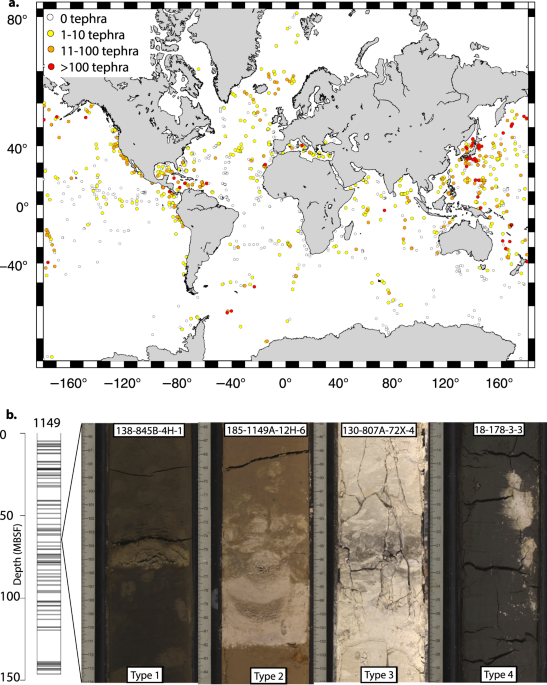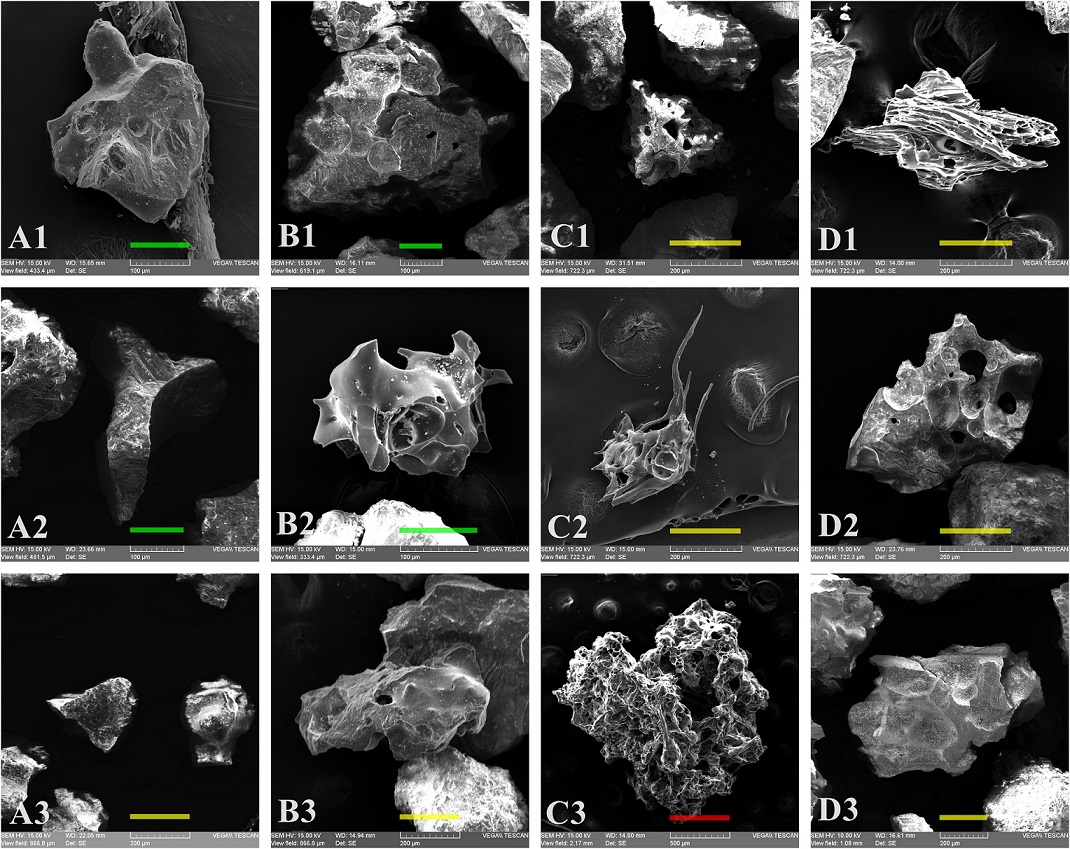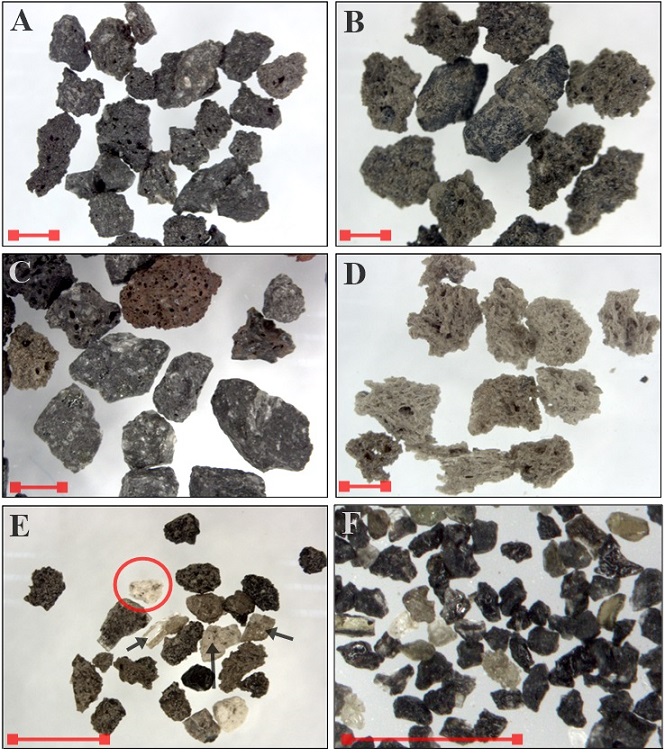Explain the Different Types of Tephra
The least-likely scenario is another caldera-forming eruption in which case much of the United States southern Canada and northern Mexico would experience some ashfall. Gray tan or orange in color.

Volcore A Global Database Of Visible Tephra Layers Sampled By Ocean Drilling Scientific Data
Tephra is a general term for fragments of rock and lava regardless of size that are blasted into the air by explosive eruptions.

. Ash is the smallest tephra. Identify two volcanoes in the Mediterranean Belt. Lapilli- Pebble size resembles cinders forms in water-rich eruptions collection of wet ash deadly 2-64mm.
Pyroclastic flows normally hug the ground and travel downhill or spread laterally under gravity. Ash falls from the sky and is deposited in layers on the ground. The largest pieces of tephra greater than 64 mm are called blocksand bombs.
Volcanic sources can occur in six different ways. Direct hazards are forces that directly kill or injure people or destroy property or wildlife habitat. Indirect hazards are volcanism-induced environmental changes that lead to distress famine or habitat destruction.
The weakest are Hawaiian and submarine then Strombolian followed by Vulcanian and Surtseyan. Helens 1980 and Mount Pinatubo 1991 were enormous they are very small compared to ancient eruptions such as. Although most people believe that Vesuvius 79 AD - the Pompeii eruption Mount St.
Composite volcanoes sometimes known as strato volcanoes are steep sided cones formed from layers of ash and lava flows. What Are The 6 Types Of Volcanoes. What are 4 types of plutonic structures.
At Mount Rainier tephra is conspicuous as sandy material in colorful shades of orange tan yellow gray brown and white. Cinder is medium-sized tephra. The four types of tephra are identified by size.
You just studied 48 terms. Stratovolcanoes are tall and cone-shaped. The most common rock types in plutons are granite granodiorite tonalite monzonite and quartz diorite.
Within these wide-defining eruptive types are several subtypes. Several types of volcanic eruptionsduring which lava tephra ash lapilli volcanic bombs and volcanic blocks and assorted gases are expelled from a volcanic vent or fissurehave been distinguished by volcanologists. Lets dive into the differences between these types of volcanoes.
When a volcano erupts it will sometimes eject material such as rock fragments into the atmosphere. Volcanologists classify eruptions into several different types. The spheres in the illustration above represent the volume of erupted tephra for some of the most widely-known explosive volcanic eruptions.
Tephra includes large rocks and small fragments such a scoria pumice and volcanic ash. Instead of flat shield volcanoes like in Hawaii they have bigger peaks. Most tephra falls back onto the slopes of the volcano enlarging it.
Helens tephra is conspicuous as sandy material in colorful shades of orange tan yellow gray brown and white. Plutonic structures include huge solidified magma chambers called batholiths laccoliths stocks bysmaliths and lopoliths while smaller hypabyssal structures include diapirs dikes and dikelets ring dykes sills. Blocks and bombs are normally shot ballistically from the volcano refer to the gas thrust zone described in the direct blastsection.
Others concern the resulting shape of the eruptive products or the place where the eruptions occur. It is a synonym for pyroclastic material Tephra ranges in size from ash 2 mm to lapilli 2-64 mm to blocks and bombs 64 mm. Densities vary greatly from that of pumice 05 to solid pieces of lava with density about 30.
Each of the volcanoes on Earth is part of the volcano complex. Convergence plate boundaries with zones and hot spots produce different types of volcanoes. The term tephra defines all pieces of all fragments of rock ejected into the air by an erupting volcano.
Indirect effects of volcanism have accounted for approximately 8 million deaths during historical times. Some volcanoes may exhibit only one characteristic type of. Tephra is a general term for fragments of rock and lava regardless of size that are blasted into the air by explosive eruptions.
The six types include Cinder Cone Volcanos Stratovolcanoes Shield Volcanics Rhyolite Volcanic Complex Monogenetic Volcanics and Flood Basalts. 3 Types of Volcanoes. Explain how the location of volcanoes is related to the theory of plate tectonics.
The stronger eruptive types are Pelean eruptions followed by Plinian eruptions. Bombs- Incandescent lava fragments not solid when ejected cools when flying. They produce tephra ash clouds and.
But billions of smaller and lighter pieces less than 2 mm diameter less than one tenth of an inch termed ash are carried by winds for thousands of miles. Some are named for particular volcanoes where the type of eruption is common. It is heavier than ash.
A pyroclastic flow is a fast-moving current of hot gas and rock collectively known as tephra which reaches speeds moving away from a volcano of up to 700 kmh 450 mph. Stratovolcano Shield and Cinder Cone. The gas can reach temperatures of about 1000 C.
Blocks and bombs are large pieces of tephra with a diameter of greater than 64 millimeters. They build up by layering lava ash and tephra. The strongest eruptions are.
Certain types of volcanoes are associated with particular types of plate boundaries. Ad Learn More Information About a Once Monthly Schizophrenia Treatment Option. Even lava-flow eruptions could include explosive phases that might produce significant volumes of volcanic ash and pumice.
These are often named after famous volcanoes where that type of behavior has been observed. This material is known as tephra. There are three main types of volcano composite or strato shield and dome.
Blocks- Ejected as solid fragments larger than 64mm. Tephra is the term used to describe rock fragments and other particles ejected from a volcano. Its tephra typically appears darker in color than tephra from Mount St.
Ash and tephra fall are the most widespread volcanic hazard. Eruptions are explosive due to the thick highly viscous lava that is produced by composite cone volcanoes. Tephra consists of pyroclastic fragments of any size and origin.
Helens and Mount Mazama. There are two classes of volcanic hazards direct and indirect. Mount Rainier rocks and tephra contain 55 to 64 percent silica.
Blocks from basement material may exceed 30. Tephra is solid material that has been shot into the air or underwater by an explosive volcano. Here are some of the most common types of eruptions.
Ash- Fine grain made of broken glass shards Crystal and lithic rock heavy and dense. Tephra includes large rocks and small fragments such as scoria pumice and volcanic ash.

Examples Of Tephra Fallout Structures From Volganic Plumes A Ash Download Scientific Diagram

Different Types Of Volcanoes Photos Volcano Volcano Photos Earth Surface

Example Of One Pyroclast From The Tephra Deposit The Right And Left Download Scientific Diagram

Pin By Dalibor Zivcak On School Earth And Space Science Science Nature Environmental Science
Tephra Fallout From The Long Lasting Tungurahua Eruptive Cycle 1999 2014 Variations Through Eruptive Style Transition And Deposition Processes Bustillos A Andean Geology

Tephra Fallout From The Long Lasting Tungurahua Eruptive Cycle 1999 2014 Variations Through Eruptive Style Transition And Deposition Processes
Tephra Fall At Tungurahua Volcano Ecuador 1999 2014 An Example Of Tephra Accumulation From A Long Lasting Eruptive Cycle

Tephra An Overview Sciencedirect Topics

Comparison Of Eruption Sizes Using Volume Of Magma Erupted U S Geological Survey

What Are Volcano Hazards Fact Sheet 002 97 Teaching Science Teaching Geography Earth Science

Volcanoes Of The World Third Edition A Review Pelee Volcano Reviews

Tephra Fallout From The Long Lasting Tungurahua Eruptive Cycle 1999 2014 Variations Through Eruptive Style Transition And Deposition Processes

Formation Mount Unzen Volcano Project Volcano Projects Earth And Space Science Volcano

Ash Aggregates In Sr Type Tephras A Concentric Laminated Accretionary Download Scientific Diagram

Plate Tectonics And Volcanoes Earth Science Chapter Ppt Download

Pin On Scientific Illiterates You Call This Information

Photographs Of Field Sites Showing Selected Tephra Deposits And Download Scientific Diagram

Comments
Post a Comment